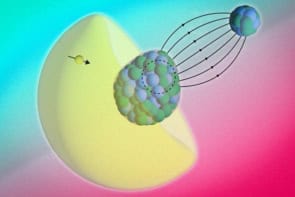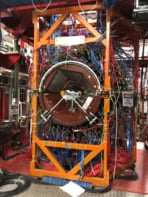Relativistic Thomson scattering has been observed for the first time by a team at the University of Michigan in the US. Classical Thomson scattering is the elastic scattering of light by electrons. The magnetic field of the light is not involved and the scattered photon has the same wavelength as the incident photon. However, if the light beam is extremely powerful ( > 1018 W cm-2), the electrons are accelerated to relativistic speeds by the electric field associated with the light beam, and the magnetic component of the field becomes important. Theory predicts that scattered photons should be radiated at multiple harmonics of the incident frequency, and that each harmonic should have its own unique angular distribution. The Michigan experiments are the first confirmation of this relativistic or nonlinear version of Thomson scattering (Nature 396 653).
Donald Umstadter and co-workers used a neodymium-glass laser to illuminate helium gas in a vacuum chamber. The team were able to focus 4 trillion watts of power on the gas. The electric field of the laser pulses ionizes the gas and causes the free electrons to oscillate back-and-forth in a straight line. The magnetic field of the laser interacts with the electrons through the Lorentz force. This force is normally very weak, but at high enough intensities the effects of the electric and magnetic fields on electron motion become comparable. The effect of the Lorentz force is to change the electron motion from oscillation in a straight line to a figure-of-eight pattern. This change causes the scattered light to be emitted as harmonics of the incident light. The researchers hope to use the technique to develop “table-top” X-ray sources.



